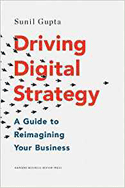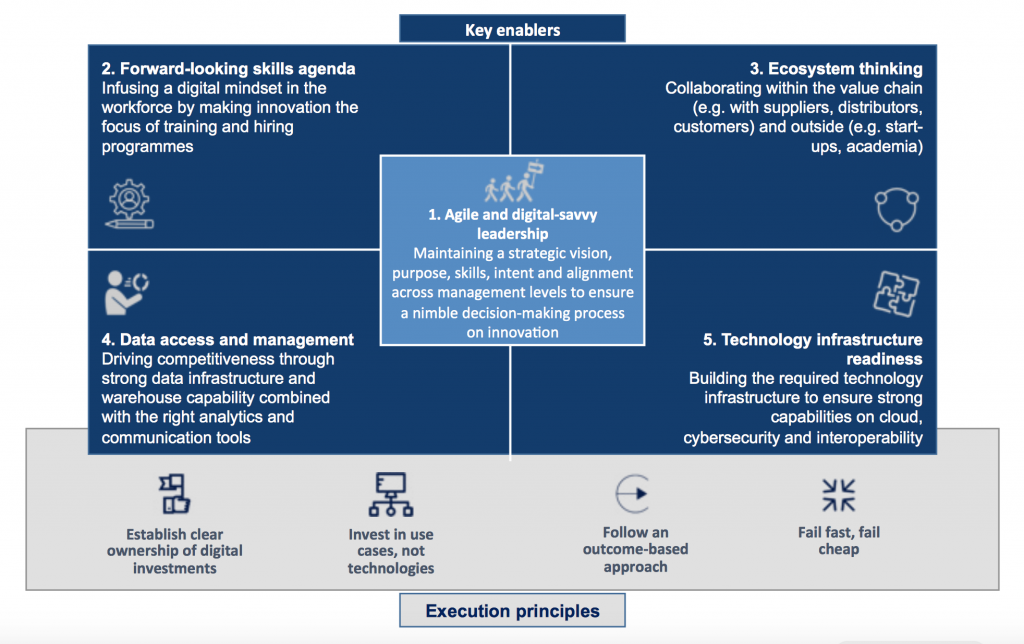
Digital blind spots hinder our progress
At several of my recent keynote presentations, I have interactively surveyed the audience and received some surprising responses. The responses indicated that the areas where leaders need to be more curious and explore are often the areas where the leaders are most vacant. It is a digital blind spot that we have in areas closest to our business and where our actions would teach us most.
I was keynote speaker at an annual Retail Day, where more than 200 leaders from the retail industry met up to listen to new trends and share experiences. It is also well known that Amazon is one of the disruptors in the retail industry on a global scale.
So, my question to the audience was to share how digital they are on a personal level. As can be seen from the chart below, the leaders are quite active, using many digital tools, but surprisingly low on exploring Amazons services. I now coin that a #DigitalBlindspot.

At another OpenBanking event hosted by FCG Group, we asked similar questions to representatives of the financial services industry to understand how many of the new consumer-oriented financial services in the market were used by the leaders of financial services. A very similar picture was shared that the exploration by the leaders was very low. – Another #digitalblindspot.
Remove #Digitalblindspots in your business strategy – Reimagine your business
The typical approach companies take when moving their organizations into the digital era is to use technology to cut costs, perform digital experiments and often set up a separate unit for managing digital innovation. The challenge with those approaches is that organizations need to strengthen their core and build for the future at the same time.
The context for our organizations is changing rapidly. Industry boundaries are blurred and no longer defined by traditional competitors. We see cinemas, television stations, channel providers and news magazines being challenged by competitors such as Netflix. And Netflix has now stated that their biggest competitors include games, like Fortnite.

Professor Sunil Gupta
During my visit to Boston in the autumn, I had the pleasure to meet with Professor Sunil Gupta at Harvard Business School. Professor Gupta is the Chair of Harvard’s General Management Program and the Co-Chair of the executive program on Driving Digital Strategy.
Based on almost ten years of research and work with globally leading companies, professor Gupta has developed a framework to help re-examine four fundamental aspects of our business.
To thrive in the digital era, Professor Gupta suggest that we need to examine our
- Strategy
- Value Chain
- Customer Engagement
- Organization Structure
I was fortunate to interview professor Gupta on challenges companies have, on his framework, as well as on his perspective on our findings that Boards and Leaders need to increase their insights, be more engaged in strategy and Innovation and align the actions.
The interview can be found in Digoshen podcast Exploring Leaders, episode 17.

- Re-imagine your business
- Define your customer around your customer, not your product, and select which customers you will be competitive to serve
- Access to your products and services, not ownership, will drive success
- Focus on experiences instead of things
- Build around ecosystems
- Facilitate and reduce transactional costs
- Re-evaluate your value chain
- Open up innovation, move R&D resources to C&D (Connect and Develop) Re-evaluate your value chain
- The convergence of physical and digital products to solutions
- Utilize digital supply chains
- Understand your channels and touchpoints
- Reconnect with your customers
- What your moments of truth
- Are you using freemium models
- Provide valuable information
- Ensure the right message at the right time
- Map the customer journey
- Measure for insight
- Rebuild your organization
- Set the vision and roadmap for future
- Ensure the broad directions
- Speed of change dictated by 1) Customer 2) Competition 3) Company
- Next tech & support: Analytics, AI, Big Data Machine Learning, Automation …

Professor Gupta gives the advice that you need to fundamentally change the core of your business and it will touch all aspects of your organization.
The excellent framework as further shared in Sunil Gupta’s recently published book Driving Digital Strategy provides guidelines and shares advice on rethinking and executing digital transformations in companies, based on lessons from digital transformation at Fortune 500 companies.
Digital #Blindspots amongst Boards and Investors
At another keynote presentation for an annual event for Corporate Board Association Members, we explored their own perspectives, if their planned activities were sufficiently preparing the company for the digital future. The result as shared below shows – Yet Another #DigitalBlindspot.

In our ongoing board research project, we are fortunate to collaborate with Research Director Stephanie Woerner MIT. MIT CISR have recently done a research project on the digital savviness of boards. When boards themselves evaluate, 62% believe they are digitally competent, but in a follow-up survey of biographies by the researchers, about 24% of the board members actually show sign of that. Another #DigitalBlindspot.
They have also revisited the boards’ digital competence correlation with the company results, where it is shown that companies with digitally savvy boards, with a minimum of three digitally savvy board directors, had 38% higher revenue growth, 34% higher ROA and 34% higher market growth. So It pays to have a digitally savvy board. Are we then also there seeing a #DigitalBlindspot at Investors’ deciding on the board composition?
#DigitalBlindspots in Leadership
In a recent article Dodging Digital Blind Spots in MIT SLOAN Management Review, based on global research they share that leaders are at risk of four digital blind spots that they should know and be aware of.
The leadership blindspots are
- Strategic – to understand that you need to create clarity in purpose, vision, and strategy
- Cultural – – that leaders talk about digital leadership but don’t practice digital leadership
- Human Capital – that leaders need to spot new trends, make things happen, invest in and motivate talents
- Personal – being aware of how digital we really are as leaders and act, be role models, and not just talk
Some similar insights are shared in the recent World Economic Forum report on Maximizing Value from Digital Investments, where they point out five key enablers including

- Agile and digital-savvy leadership
- Forward-looking agenda skills
- Ecosystems thinking
- Data access and management
- Technology and infrastructure readiness
An interesting example of an organization picking up on the need to transform their core as well as the need for adjusted leadership is Royal Bank of Canada, RBC, a financial services giant. They have been engaged in comprehensive digital transformation over the last years, however, only recently the RBC’s leadership came to terms with the notion that to fully execute its digital transformation, it needed leaders who fully embrace and understand how to compete and lead in the new economy. The company has also completely transformed its leadership model and its talent strategy. There are some valuable insights shared in their document About Value for Employees;
The document highlights the establishment of a board level Human Resource Committee to oversee both traditional remuneration questions, but also talent management strategy and practices, as well as key leadership skills and appointments. The four focus areas are
- A new leadership model
- Building talent for growth
- Accessibility and transparency
- Performance enablement
They note that leaders shape the future, build talent and provide context to inspire and engage people in a rapidly changing environment, maintaining focus on what matters most to deliver growth. The RBC Leadership Model defines the capabilities and behaviours that matter most to their future success. That includes the ability to drive impact, to adapt quickly and always learn, to unlock and develop the potential of their people and to speak up for the good of the company.
RBC CEO Dave McKay role models and frequently shares articles on LinkedIn, as his view on their home country’s future and importance for them, and an insightful sharing from what he learned at the last Davos meeting.
And as a good reminder, in a BCG study of 40 digital transformations, companies that focused on culture were 5 times more likely to achieve breakthrough performance than companies that neglected culture.
Why it’s important to remove the digital blind spots

Digitally mature companies find new growth 78% more common, increase the speed to market (62%) and are more cost efficient (60%), as found in the research Digital Maturity is paying off by BCG
A similar finding was done by McKinsey in their research, where they found that B2b digital leaders drove five times more revenue growth than their peers.
How to become more digitally involved and remove #DigitalBlindspots
To get more insight and fill in your digital blind spots, we recommend you explore, understand and build more knowledge of new trends and businesses.
We recommend you to read the book Driving Digital Strategy and follow Professor Sunil Gupta on Twitter.
If you are fortunate to be in the Nordics May 27-29, you will have the opportunity to meet Professor Gupta. He will be speaking in an arrangement by the Tatarklubben in Copenhagen and in collaboration with American Chamber of Commerce in Sweden in Stockholm, by American chamber of commerce in Finland in Helsinki and by American Chamber of Commerce in Norway in Oslo.
You also find interesting business and leadership matters at Harvard Business Review and you can follow HBR on Twitter and also their Harvard Digital Initiative on Twitter
You will get more digital insights if you follow these thought leaders on twitter Stephanie Woerner MIT and MIT CISR, MIT Initiative on Digital Economy, Andrew Macafee and Eric Brynjolfson.
You will also find more inspiration following INSEAD Knowledge via twitter and learn more at digital@INSEAD.
World Economic Forum, WEF, shares relevant insights. Read their new report on Maximizing Value from Digital Investments.
Another way to stay updated is to listen to podcasts or read digital magazines & blogs. At Digoshen we curate podcast lists & digital magazines and update them regularly.
You find inspirational podcast lists here , as for example Digoshen Recommends podcast list. And weekly updated Digital Magazines we share here.
We also recommend you revisit how you can become better in firefighting. We recommend the training and insights shared by Institute For the Future, IFTF, in Palo Alto.
IFTF also shares Foresight talks, an interesting webinar together with Microsoft and their Foresight team, and an upcoming webinar in collaboration with Stanford, “How the Stanford d.school is Making Design Thinking Future-Ready”
Learn from other leaders interviewed by Digoshen
You can find inspiration from some of the earlier Digoshen blogposts, and from episodes at our podcast Exploring Leaders.
Anastassia Lauterbach, NED Digital Board Director
Denise Koopmans, NED Digital Board Director
Mark Dennis, Digital CEO Sony Sweden
Rohit Sharma, Digital VC Investor
________________________
These interviews are shared both on my own blog www.liselotteengstam.com as well as on the blog of Digoshen www.digoshen.com, where I am Chairman of the Board.
At Digoshen we work hard to remove #digitalblindspots. We believe that Companies, Boards and Business Leadership Teams need to understand more of the digital world to fully leverage the potential when bringing their business into the digital age.
To understand where you and your company stand in relation to digital business and leadership progress, take our survey at Digoshen.com/researchand get a free of charge personalized report with recommendations on how to move forward. The survey is anonymous and takes about 15 minutes to complete.
You will find more insights via Digoshen Website and welcome to follow us on twitter: @digoshen , our CEO @katycaroan and Chairman @liseeng
